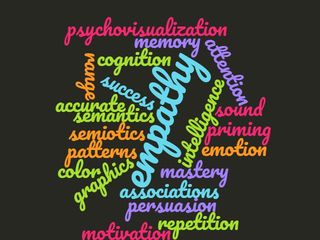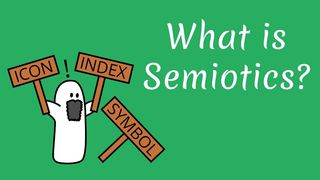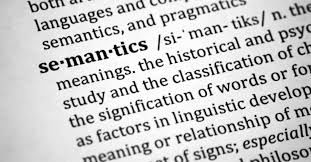Synesthesia
Synesthesia, Semiotics, Semantics and How We Learn
FMRI: The key that unlocks new understanding about the psychology of learning.
Posted June 30, 2019
Luskin Learning Psychology Series No. 46

Each person's perception is individually unique and subjective (Cytowic 2018.) Anesthesia is the phenomenon of no sensation. Synesthesia is the phenomenon of multiple sensations. Human senses include hearing, seeing, feeling, touching, experiencing and remembering. Physically, each sensory modality is separate. We hear with ears; we see with eyes and touch with skin. Perception, including sensory couplings, happens to everyone all the time. A synesthete is one who has an extraordinary, magnified and unique sensory experience. Everyone is not a synesthete or savant. There are only a small number of synesthetes or savants. We know now, however, that every person experiences his or her own level and form of synesthesia. Everyone experiences synesthesia. To enable communication as we know it, synesthesia involves the physical and perceptual interpretations of semiotics (symbols) through our brain, perceiving icons and emoticons and semantics (i.e., the understanding of meaning, words and language that converge in communication leading to understanding.) Semiotics is communication through signs and symbols.
There is a substantial and increasing body of literature on synesthesia, semantics, and semiotics, perception and understanding. A new understanding is now possible and validated by using FMRI (functional magnetic resonance imaging). FMRI enables monitoring, measuring and understanding how perception, the brain, meaning, and learning converge. Now, because of advanced technology, including FMRI, we understand more than ever before. We also recognize that substantial new research is needed. We are poised on the edge of exciting new learning paradigms. Our knowledge about how we learn is advancing. This type of understanding will revolutionize the field of learning psychology.
I am an educator whose research investigates the learning experience, especially in adults. My conclusion is that synesthesia, semiotics, and semantics can be expressed as a 3-S Model wherein these three modalities combine in ways that enable everyone’s understanding and communication capability.

Semiotics includes the understanding and meaning of symbols. Semantics adds the cross-model perception and understanding of the use and meaning of words. When these 3-Ss combine, they are perceived (i.e., there is perception) and learning occurs. With the emergence of digital signal processing, the internet, and all the related functions, diversity in communication and learning are rapidly changing. Computers, iPads, iPhone and Apple Watch-type wrist devices, cable, satellite and all forms of social media, have changed the world and, thereby, dramatically impacted learning.
Learning Psychology combines the theories in psychology that foster learning. It is important to remind ourselves that the fabric of psychology is a weave consisting of more than one-hundred theories. For purposes of my explanation, learning psychology embodies theories in psychology that enhance each learning experience. Learning theories include a wide range of topics including emotion, empathy and accurate empathy, perception, persuasion, psychovisualization, repetition, attention, color, sound, graphics, motivation, memory, mastery, success, intelligence, semantics, semiotics, cognition, priming, associations, and understanding patterns to make meaning.
Media Psychology involves theories in psychology applied to media, i.e., pictures, graphics, and sound, transmitted through technology.
Marshall McLuhan (McLuhan 1967) famously separated media-technology and psychology by explaining that “the medium is the massage,” and “the message is the message.” If you separate the message from the internet, iPhone, iPad, laptop computer, Apple Watch, and other communication delivery vehicles, you do separate the message from the massage. Simply stated, the fundamentals of basic subjects such as English, chemistry, accounting, mathematics, etc., remain the fundamentals even when they are manipulated through communications technology. The APA Society for Media Psychology and Technology, Division 46 of APA, has media psychology as its focus as a sub-specialty in the broader field of psychology. Media psychology is also a sub-category and specialty within Learning Psychology.
Blended, online, and distance learning on the World Wide Web offer a wide-ranging case study for learning and media psychology. Synesthesia, semantics, and semiotics combine to comprise a 3-S Model metaphor relevant to understanding learning and media psychology. Today’s internet is a global network of thoughts and ideas. Learning occurs through perception in the brain. It is unique to each individual and to how each person understands what is perceived.

Emotion triggered by sensory stimuli is labeled synesthesia. Synesthesia includes perception, i.e., experiencing a confluence of the senses. Synesthesia, semiotics, and semantics combine as factors in learning. There is a substantial and growing body of literature on multisensory interaction, including the influence of sensory effects on perception. Sound, for example, can augment tactile stimulation and/or visual perception. Sound can make you feel tactile sensations on your skin. Research on filmmaking has validated the importance of music to audience response. These are some examples of the many multi-sensory stimulations that we perceive.
Sensory experiences manifest in various ways. Feelings and responses are experienced and perceived during communication between areas within the brain. Emotion, for example, is a normal sensory function. Synesthesia includes the sensory response that we have without thinking or necessarily being consciously aware that we are experiencing it. Synesthetes do it and they know they do it. Synesthesia is sensory psychology. A synesthete is an individual with special and heightened sensory awareness. I am not focusing on synesthetes as individuals here. My goal is the exploration of universal synesthesia as it involves everyone’s sensory experience. For an in-depth explanation of synesthetes, see Richard Cytowic’s Synesthesia (Cytowic 2018.)
As an educator studying education through online learning, many of the applications I am exploring are populist and applied in blended and online situations. We now have computer programs and applications at our fingertips that profoundly affect the ways we learn and improve comprehension… with a click. Media tools are more accessible than ever and impact us in both subtle and overt ways on every level, from learning a new language to sharpening a myriad of skills. One example is Microsoft Office 365, a monthly subscription that automatically upgrades and augments the MS Office suite of tools. The Read-Aloud feature in Word can read your document out loud like an audiobook and highlight each word simultaneously as it's being read

Reading aloud can help you learn a new language and, along with other Learning Tools, helps improve reading skills for many, as well as those with learning disabilities like dyslexia. Applications, like Microsoft's Read Aloud, encompass the precepts of the 3-S Model and underscore Synesthesia, Semantics, and Semiotics as an area warranting substantial media psychology research.
I am hopeful that this discussion will reach an increasingly expanding audience of learning psychologists and educational researchers interested in expanding their research to advance learning psychology and technology. We now have the tools to measure learning in new ways, leading to greater understanding.
Summary:
Synesthesia is the response resulting from a union of the senses. Semiotics includes the development, identification, use, coupling and integration of symbols for purposes of communication, language and understanding. Semantics is the use and understanding of words and language. Learning and media psychology are comprised of many theories in psychology applied to learning. As noted earlier, theories such as attention, persuasion, attachment, and memory make up the field of learning psychology. The internet, iPhone, social media, wrist-watch devices, laptops, iPads, GPS technology, and many more devices we use to manage and massage messages, have caused learning psychology and media psychology to converge. Media Psychology is a sub-specialty within Learning Psychology. Understanding learning, and relating cognition to brain function, is an important emerging area of research. FMRI technology has greatly increased our knowledge about learning that results from the stimulation of our senses and the multisensory response. Synesthesia includes responses to graphics, musical sounds, personalities, odors, pain, touch, taste, smell, temperature, hearing, and all their combinations. Synesthesia exists normally throughout the total population and everyone experiences synesthesia, but not everyone is a synesthete.
My work in learning concentrates on everyone’s learning experience enhanced through synesthesia, powered through semiotics, semantics and more in our research to identify the best methods and techniques for communication and understanding in teaching and learning.
Recommendations:
- Encourage broad discussions and research about the relationship between learning and media.
- Encourage educators and researchers to advance learning psychology through their new insights and findings.
- Continue our eternal search for meaning.
Please email me your comments or suggestions: Bernie@LuskinInternational.com.
Special Appreciation: Thanks to Toni Luskin, Ph.D. for editorial, graphics and subject matter support and expertise.
Author: Bernard Luskin, Ed.D., LMFT is a licensed Marriage and Family Therapist, School Psychologist and Fellow of the American Psychological Association whose research specialties include Media Psychology and Learning Psychology.
References
References:
Cytowic, R. E. (2018). Synesthesia. Cambridge, MA: MIT Press.
Hayakawa, S.I. (1970). Dimensions of meaning. Macmillan Pub. Co. London, UK: Penguin Books.
Luskin, B., (2019). Synesthetics, Semiotics, Semantics: The 3S Metaphor in Learning, Amplifier, APA Link: https://div46amplifier.com/2019/06/12/synesthetics-semiotics-semantics-…
McLuhan, M., Fiore, Q., & Agel, J. (1967). The Medium is the Massage. An inventory of effects. Society for Media Psychology and Technology, APA Division 46, Spring, 2019




